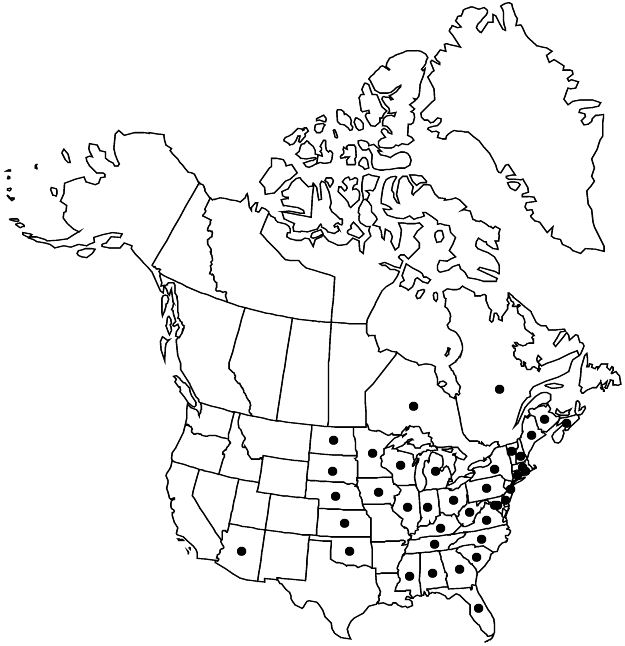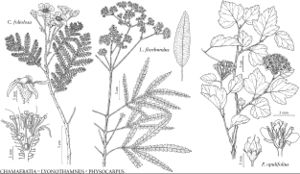Difference between revisions of "Physocarpus opulifolius"
Trudy Imp. S.-Petersburgsk. Bot. Sada 6: 220. 1879.
FNA>Volume Importer |
FNA>Volume Importer |
||
| Line 13: | Line 13: | ||
}}{{Treatment/ID/Special_status | }}{{Treatment/ID/Special_status | ||
|code=F | |code=F | ||
| − | |label= | + | |label=Illustrated |
}} | }} | ||
|basionyms={{Treatment/ID/Basionym | |basionyms={{Treatment/ID/Basionym | ||
|name=Spiraea opulifolia | |name=Spiraea opulifolia | ||
|authority=Linnaeus | |authority=Linnaeus | ||
| + | |rank=species | ||
|publication_title=Sp. Pl. | |publication_title=Sp. Pl. | ||
|publication_place=1: 489. 1753 | |publication_place=1: 489. 1753 | ||
| Line 24: | Line 25: | ||
|name=Opulaster alabamensis | |name=Opulaster alabamensis | ||
|authority=Rydberg | |authority=Rydberg | ||
| + | |rank=species | ||
}} {{Treatment/ID/Synonym | }} {{Treatment/ID/Synonym | ||
|name=O. australis | |name=O. australis | ||
|authority=Rydberg | |authority=Rydberg | ||
| + | |rank=species | ||
}} {{Treatment/ID/Synonym | }} {{Treatment/ID/Synonym | ||
|name=O. opulifolius | |name=O. opulifolius | ||
|authority=(Linnaeus) Kuntze | |authority=(Linnaeus) Kuntze | ||
| + | |rank=species | ||
}} {{Treatment/ID/Synonym | }} {{Treatment/ID/Synonym | ||
|name=O. stellatus | |name=O. stellatus | ||
|authority=Rydberg ex Small | |authority=Rydberg ex Small | ||
| + | |rank=species | ||
}} | }} | ||
|hierarchy=Rosaceae;Rosaceae subfam. Amygdaloideae;Rosaceae tribe Neillieae;Physocarpus;Physocarpus opulifolius | |hierarchy=Rosaceae;Rosaceae subfam. Amygdaloideae;Rosaceae tribe Neillieae;Physocarpus;Physocarpus opulifolius | ||
| Line 57: | Line 62: | ||
-->{{#Taxon: | -->{{#Taxon: | ||
name=Physocarpus opulifolius | name=Physocarpus opulifolius | ||
| − | |||
|authority=(Linnaeus) Maximowicz | |authority=(Linnaeus) Maximowicz | ||
|rank=species | |rank=species | ||
| Line 71: | Line 75: | ||
|publication title=Trudy Imp. S.-Petersburgsk. Bot. Sada | |publication title=Trudy Imp. S.-Petersburgsk. Bot. Sada | ||
|publication year=1879 | |publication year=1879 | ||
| − | |special status=Endemic; | + | |special status=Endemic;Illustrated |
| − | |source xml=https://jpend@bitbucket.org/aafc-mbb/fna-data-curation.git/src/ | + | |source xml=https://jpend@bitbucket.org/aafc-mbb/fna-data-curation.git/src/f50eec43f223ca0e34566be0b046453a0960e173/coarse_grained_fna_xml/V9/V9_572.xml |
|subfamily=Rosaceae subfam. Amygdaloideae | |subfamily=Rosaceae subfam. Amygdaloideae | ||
|tribe=Rosaceae tribe Neillieae | |tribe=Rosaceae tribe Neillieae | ||
Revision as of 22:42, 16 December 2019
Shrubs, to 30 dm. Stems spreading to ascending, ± glabrous. Leaves: stipules narrowly ovate, 6–10 × 1.5–2.5 mm, apex acute; petiole 1–3 cm; blade ovate to obovate, 6–8.5(–10) × 4–7(–10) cm, usually longer than wide, base broadly cuneate to truncate, 3(–5)-lobed, margins irregularly serrate, apex obtuse to rounded, surfaces mostly glabrous, sometimes sparsely hairy abaxially. Inflorescences 30–50-flowered, open, hemispheric racemes, 5 cm diam.; bracts elliptic to spatulate or rhombic, 5 × 2.5 mm, apex acute to 3-fid or coarsely erose, faces glandular. Pedicels 1–2 cm, usually stellate-hairy. Flowers 7–10 mm diam.; hypanthium cup-shaped, 1.5–2 mm, glabrous or sparsely stellate-hairy; sepals pale green to white, darker in center, triangular, 1.5–2.5 mm, apex mucronate, gland-tipped, surfaces usually stellate-hairy; petals white to pale pink, broadly elliptic to orbiculate, 4–5 × 4–5 mm; stamens equal to or exceeding petals, anthers purplish; carpels 3–5, connate basally, sparsely stellate-hairy, glabrescent. Follicles 3–5, connate basally, bright red to brownish red, ovoid, 5–10 mm (lengths ca. 2 times sepals), sparsely stellate-hairy, ± glabrescent; styles 4 mm. Seeds 2(–5), pyriform, 2 mm. 2n = 18.
Phenology: Flowering May–Jun; fruiting Jul–Sep.
Habitat: Rocky stream banks, lake shores, moist woods, swampy ground
Elevation: 0–1300 m
Distribution

N.B., N.S., Ont., Que., Ala., Ariz., Conn., Del., D.C., Fla., Ga., Ill., Ind., Iowa, Kans., Ky., Maine, Md., Mass., Mich., Minn., Miss., Nebr., N.H., N.J., N.Y., N.C., N.Dak., Ohio, Okla., Pa., R.I., S.C., S.Dak., Tenn., Vt., Va., W.Va., Wis., introduced in Europe.
Discussion
Physocarpus opulifolius is the most widespread species in the wild and is commonly cultivated in North America and Europe; it occasionally escapes from cultivation and has become established in parts of Europe.
Selected References
None.
